According to the extraordinary mind of a visionary intellectual like Ettore Sottsass, there are «things very difficult to say»[1]. Among these we can find the ability to create connections, answering the question «what does it have to do with it, where is the relationship?»[2]. Indeed, these are the questions that inspired the realization of the exhibition PALAZZO FARNESE CONTEMPORARY, generated by pianobi’s second outdoor project curated by Isabella Vitale. On this occasion, in May 2023, a selection of artists was invited to engage with the historic Palazzo Farnese in Rome – current location of the French Embassy. From this, an eventful journey was originated, where each participant spontaneously created an exhibition path methodically conceived by the curator through a careful mediation between the artist’s language and the historical environment of the palace. If today we are aware of the existence of various forms of expression, due to a happily fragmented and lively art of diverse languages, Vitale’s project does not appear shapeless: on the contrary, it is rich in content and strongly balanced, as no artist’s work prevails over the others with dominance. Therefore, what was produced in March 2023 is currently on display at the pianobi space in Rome until February 28th, 2024. Moreover, the exhibition setup is a joyful initiative, capable of narrating artistic aspects, in a cultured and ingenious tone, which are normally difficult to understand but are now presented in the clarity of a delicate dialogue.
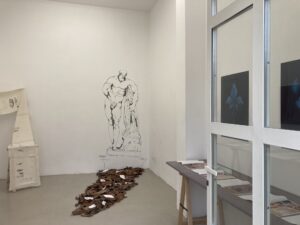
PALAZZO FARNESE CONTEMPORARY, outdoor project #2, exhibition view, pianobi, Rome, 2023. Courtesy pianobi
Among all the exhibited works, Luca Grechi’s papers stand out for their genuine simplicity. Without being excessively bound to his model, he reinterprets some details of the ceiling painted by the Carracci brothers in Palazzo Farnese. The result is drawings in which the frescoes take on the most concise synthesis: pencil, charcoal, and chalk lines with an undulating, arabesque flow characterized by surprising genuineness and harmonious elegance. This creative freshness is achieved through the sole mediation of the mirror, through which the artist traces figures marked by an aerial motion that gracefully hovers on the white sheet. As a result, these papers seem to pose the question: what does it mean to see for Grechi? The ensuing answer appears detailed and unequivocal: to scrutinize is to petrify past events that, in the artist’s sober and clear gaze, emerge as an act of mediation, a moment of encounter between thought and intuition, where visual adjustments and compromises coexist. For Grechi, referring to a pictorial tradition does not equate to glorifying the cult of ashes but rather to safeguarding its fire, air, and all the elements that sustain such energies.

Luca Grechi, Riflessi, 2023. Lapis, charcoal, fudge on paper, 33×48 cm. Courtesy the artist and pianobi
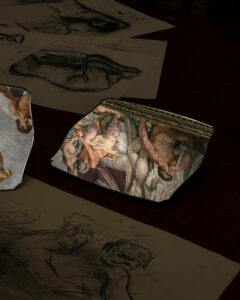
Luca Grechi, Riflessi, 2023. Ph. Luigi Vitiello, courtesy the artist and pianobi
In a similar way, Elene Usdin also reproduces the Carracci frescoes, depicting scenes in total atmospheres and positioning herself as a reformer of the frescoed ceiling through the use of the colored ballpoint pen technique, that, instead of softening the contrasts, it enhances them, revealing points of agreement. Thus, the figures appear drawn in cloisonné, and their incised linearity brings forth a lively and luminous trait, both entertaining and entertained, never devoid of a triumphant and lyrical vein. A harmonious agreement toward something broader, not necessarily visual, is the saxophone melody composed by Mattia Abballe, which is presented in the exhibition on magnetic cassette tapes. This makes the most celebrated element among all the arts the connecting thread among all the exhibited pieces. Furthermore, the soundtrack is characterized by an energetic and elegant rhythm, becoming an iconic element of a necessary deep fusion. In this way, Abballe uses music as a mental womb, devising a lyric suspended poetically between the historicity of Palazzo Farnese and the relentless rhythms of everyday life.
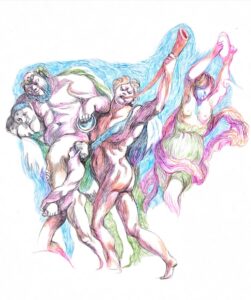
Elene Usdin, Riflessi, 2023. Colored ballpoint pen on paper, 40×30 cm. Courtesy the artist and pianobi
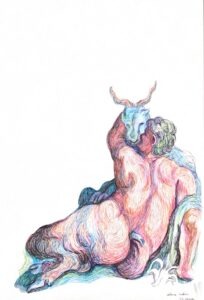
Elene Usdin, Riflessi, 2023. Colored ballpoint pen on paper, 40×30 cm. Courtesy the artist and pianobi
Another artist who presents his work akin to a musical collage, uniting harmonious and contrapuntal coloristic bonds, is Paolo Assenza. He creates drawings depicting blue irises, presumably icons of the Farnese family, which magnetically emerge on sheets of dark paper with typographic ink. The array of flowers seems defined by the rhythm of the wind and the artist’s fingers that, rubbing oil pastels on the paper with minimal marks and maximum strength, define a suspended and impetuous track with fervent and turbulent strokes. The resulting icon is Assenza’s identifying mark: seemingly detached, restless, and certainly nonconformist, always driven by a constant and passionate stylistic exploration. On the strength of the mark and line, Elena Nonnis’ work is placed; she is a refined storyteller who expresses herself with delicate stitches defining the shapes of a group of visitors in front of the statue of Hercules. The scene is laid on fabric like a cinematic montage, essential threads intending to give shape and substance to a contemporary event at the Palazzo, using a minimal language intentionally leaving parts unfinished. However, the artist is not interested in the emulation of the real, on the contrary, the latter is the most formidable and adversarial element because her intent remains the translation into the candid and neutral space of the fabric.

PALAZZO FARNESE CONTEMPORARY, outdoor project #2, exhibition view, pianobi, Rome, 2023. Courtesy pianobi
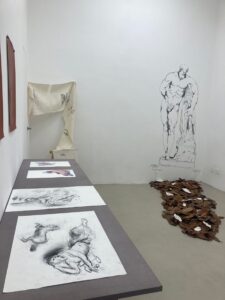
PALAZZO FARNESE CONTEMPORARY, outdoor project #2, exhibition view, pianobi, Rome, 2023. Courtesy pianobi
Unlike all the artists in the exhibition, Valentina Palazzari puts herself into the groove of a well-defined physical and psychological realm, emphasizing the idea that there is no certainty except for probability alone. The artist conceives an intense dialogue with the statue of Hercules Farnese, generating a fascinating performative action that gives rise to leaves covered in stucco, arranged like a terrestrial mantle in the exhibition space. This work, and the action that brought it to life, tacitly and tenaciously encourages the mind to think according to the artist’s rigorously repeated and formalized acts, doing so the tautological statement transcribed on the leaves, “La Fragilité d’Hercule” (The Fragility of Hercules), reaffirms the importance of a fragile mental state. Leonardo Petrucci’s drawings rhythmically mark the exhibition space, fixing the live position of the model on red paper in the Salone Rosso of the Palazzo Farnese. The certainty of the hand and the lightness of the stroke translate the melancholic and dreamy beauty of the figure, leading us toward a thoughtful misunderstanding, as the model takes up the pose of the Venere Callipigia that belonged to the Farnese family. The artist, hinting at the outline in a simple and intuitive way, skillfully highlights the details, leaving aside the more aestheticized forms and bestowing a nervous elegance. Finally, with the LU.PA duo, identity becomes a dangerous and reactionary concept, as there is nothing more shapeless than the substance of the minds of the artists that, during a performance, produced drawings using the frottage technique. In this action, the calibrated gestures and the cold, penetrating eyes of the performers were focused on transcribing the word “parla” (speak), transcribed on papers portraying naturalistic details of the Palazzo, stimulating the shock of the unknown and the weight of a spirit called to elaborate the principle of the verb. This mental attitude informs all the works in the exhibition, allowing them to draw on a witty and cultured visual and verbal reasoning, making clear the relationships that are usually very difficult to express, but which are honestly and deeply explored by pianobi.
Maria Vittoria Pinotti
[1] Ettore Sottsass, Molto difficile da dire, Piccola biblioteca Adelphi, Milano, pp. 101-102.
[2] Ibidem.
Info:
various artists, PALAZZO FARNESE CONTEMPORARY
curated by Isabella Vitale
pianobi outdoor project #2
20/12/2023 – 28/02/2024
pianobi
via dei Ciceri 97-99, 00175 Rome
pianobi.info
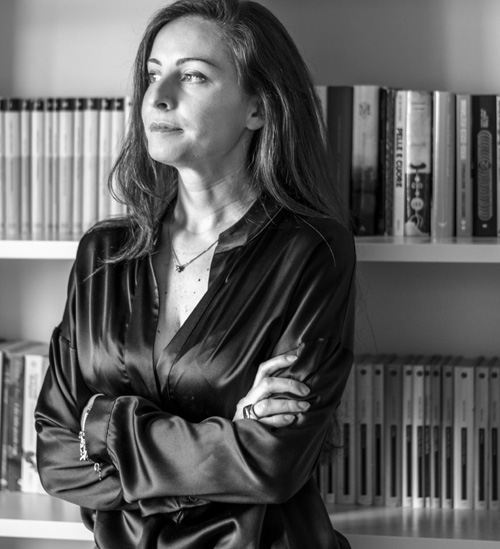
Maria Vittoria Pinotti (1986, San Benedetto del Tronto) is an art historian, author, and independent critic. She currently is the coordinator of Claudio Abate’s photographic archive and Manager at Elena Bellantoni’s Studio. From 2016 to 2023 she was the Gallery Manager in a gallery in the historic center of Rome. She has worked with ministerial offices such as the General Secretariat of the Ministry of Culture and the Central State Archive. Currently, she collaborates with cultural sector magazines, focusing on in-depth thematic studies dedicated to modern and contemporary art.






NO COMMENT